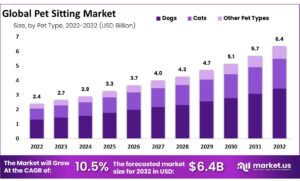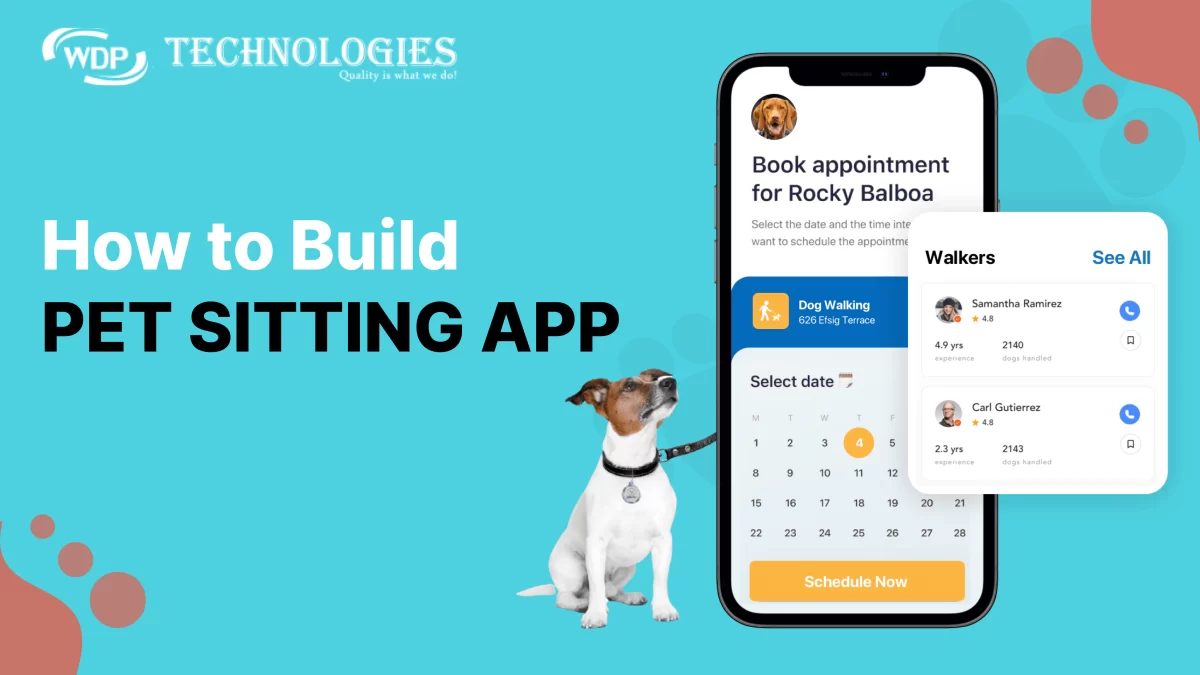In a world where our furry friends hold a special place in our hearts, the demand for reliable and convenient pet care services has soared to new heights. Whether it’s a weekend getaway, a long day at the office, or simply the need for a helping hand in managing our beloved pets, the quest for trustworthy and personalized pet sitting solutions is on the rise. If you’re a passionate pet lover or an aspiring entrepreneur with a knack for technology, it’s time to embark on a journey to create your very own Pet Sitting App.
Welcome to a world where wagging tails meet cutting-edge technology, where pet owners can find peace of mind and where your entrepreneurial spirit can thrive. In this blog post, we’ll guide you through the essential steps for Pet Sitting App development that not only meets the needs of pet owners but also creates a seamless and enjoyable experience for both pets and sitters. So, leash up your ambition, grab a cup of coffee, and let’s dive into the exciting world of crafting a perfect pet sitting app!
What Is Pet Sitting Business?
A pet sitting business is a service where individuals or companies provide care for pets while their owners are away. Pet sitters typically visit the pet’s home to feed them, provide companionship, exercise, and administer any necessary medications. Some pet sitting services may also offer additional services such as dog walking, grooming, or overnight stays. Pet sitting businesses aim to provide a convenient and comfortable alternative to traditional boarding facilities, allowing pets to remain in their familiar environment while their owners are traveling or unable to care for them temporarily.
How Does a Pet Sitting App Work?
A pet sitting app typically works by connecting pet owners with pet sitters or caregivers through a digital platform. Here’s a general overview of how a pet sitting app works:
🔹Registration: Users (both pet owners and pet sitters) download the app from the app store and create an account by providing necessary information such as name, contact details, and sometimes verification of identity or background checks.
🔹Profile Creation: Both pet owners and pet sitters create detailed profiles including information about themselves (for sitters: experience, skills, certifications, etc.) and their pets (for owners: breed, age, medical conditions, etc.).
🔹Search and Matching: Pet owners can search for available pet sitters based on location, availability, services offered, reviews, and other criteria. The app uses algorithms to match pet owners with suitable pet sitters based on their preferences and requirements.
🔹Booking: Once a pet owner finds a suitable pet sitter, they can request a booking through the app. The sitter has the option to accept or decline the booking based on their availability.
🔹Communication: The app facilitates communication between pet owners and pet sitters, allowing them to discuss details such as feeding schedules, medication instructions, exercise routines, and any other special requirements.
🔹Services: Pet sitters provide the agreed-upon services such as feeding, walking, playtime, grooming, or overnight stays, depending on the owner’s needs and the arrangements made.
🔹Payment: The app typically handles payment transactions securely, either by charging the pet owner’s credit card or using an in-app payment system. Payment may be processed either upfront or after the service is completed, depending on the app’s policies.
🔹Reviews and Ratings: After the service is completed, both pet owners and pet sitters can leave reviews and ratings for each other, which helps build trust and reputation within the community.
🔹Additional Features: Some pet sitting apps may offer additional features such as GPS tracking of pet walks, photo updates, emergency alerts, insurance coverage, and customer support.
Overall, pet sitting apps streamline the process of finding, booking, and managing pet care services, making it convenient for both pet owners and pet sitters to connect and arrange pet care whenever needed.
Pet Sitting App Industry Market Statistics

Here is some information about the pet sitting app industry market statistics:
- Market size: The global pet sitting market size was estimated at USD 1.94 billion in 2021 and is expected to reach USD 2.15 billion in 2022. The market is expected to grow at a compound annual growth rate of 11.52% from 2022 to 2030 to reach USD 5.14 billion by 2030.
- Market trends: The pet sitting market is driven by a number of factors, including the increasing number of pet owners, the rising disposable income of pet owners, and the increasing urbanization of the population. These factors are leading to a growing demand for convenient and affordable pet care services.
- Regional trends: North America is the largest market for pet sitting, followed by Europe and Asia Pacific. The North American market is expected to continue to grow at the fastest rate, due to the high number of pet owners and the increasing popularity of pet sitting apps.
Why Pet Sitting App is Gaining Popularity
The surge in popularity of pet sitting apps can be attributed to several factors, reflecting a changing landscape in pet care preferences and the evolving needs of modern pet owners. Here are some key reasons why pet sitting apps have gained immense popularity:
1. Convenience at Your Fingertips:
In today’s fast-paced world, convenience is king. Pet sitting apps allow pet owners to effortlessly connect with reliable and qualified pet sitters with just a few taps on their smartphones. The convenience of scheduling, tracking, and managing pet care services from the palm of your hand is a game-changer for busy individuals who want the best for their pets without added stress.
2. Personalized Pet Care:
Pet sitting apps offer a personalized and tailored experience for both pet owners and their furry companions. From specifying dietary restrictions to outlining daily routines and special needs, these apps enable users to communicate their pet’s unique requirements, ensuring that sitters can provide individualized care and attention.
3. Trust and Transparency:
Trust is paramount when it comes to leaving your pet in someone else’s care. Pet sitting apps typically include features such as user reviews, background checks, and real-time updates during pet sitting sessions. This level of transparency fosters trust between pet owners and sitters, giving users the confidence that their pets are in capable and caring hands.
4. Flexibility for Pet Sitters:
For aspiring pet sitters, these apps offer a platform to showcase their skills and passion for animals. It provides an opportunity to create a flexible schedule and earn income doing something they love. The convenience of finding pet sitting opportunities through a centralized platform has attracted a growing community of pet care enthusiasts.
5. Emergency Preparedness:
Pet sitting apps often include emergency features such as contact information for veterinarians, nearby pet hospitals, and easy access to the pet’s medical history. This level of preparedness can be crucial in unforeseen circumstances, offering reassurance to pet owners that their pets are in capable hands, even during unexpected situations.
6. Social Connection and Updates:
Pet owners often enjoy staying connected with their pets, even when they’re away. Many pet sitting apps provide features for sitters to share photos, videos, and updates on the pet’s well-being during the sitting period. This not only reassures pet owners but also creates a sense of joy and connection, bridging the gap between owner and pet.
Leading Apps for Pet Sitting
Here are some of the leading apps for pet sitting, along with a brief overview of each:
a. Rover:
Founded in 2011, Rover is a popular pet sitting app that connects pet owners with vetted pet sitters and dog walkers. It operates in the United States, Canada, the United Kingdom, and Australia. Rover offers a variety of services, including dog walking, house sitting, drop-in visits, and boarding. it also boasts a robust safety features, including background checks, pet insurance, and 24/7 customer support.
b. Wag!:
Founded in 2015, Wag! is another popular pet sitting app that offers dog walking, pet sitting, and drop-in visits. It operates in the United States and Canada. Wag! is known for its on-demand services, which allows pet owners to book a pet sitter in as little as 30 minutes. It also offers features like GPS tracking and live video updates, giving pet owners peace of mind.
c. Trusted House sitters:
Founded in 2003, TrustedHousesitters is a global platform that connects pet owners with house sitters who provide in-home pet care. It operates in over 190 countries. TrustedHousesitters is unique in that it focuses on house sitting, rather than dog walking or drop-in visits. This can be a good option for pet owners who are traveling for longer periods of time or who have multiple pets.
d. Pet Backer:
Founded in 2014, PetBacker is a popular pet sitting app in China. It offers a variety of services, including dog walking, pet sitting, boarding, and grooming. PetBacker is known for its competitive pricing and its wide range of services. It has also been expanding its international reach in recent years.
e. Holidog:
Founded in 2012, Holidog is a popular pet sitting app in Europe. It offers a variety of services, including dog walking, pet sitting, boarding, and daycare. Holidog is known for its user-friendly platform and its focus on building a community of pet lovers. It has also been expanding its international reach in recent years.
How to Build a Pet Sitting App?
Building a pet sitting app involves several steps, from conceptualization to development and launch. Here’s a general guide to help you get started:
1. Market Research:
Understand the existing pet sitting app landscape. Identify your target audience, their needs, and the features that are currently popular. Analyze your competitors to find gaps in their services that your app can address.
2. Features & Functionality:
List the core features your app will offer. This may include user registration, profile creation, booking services, in-app messaging, payment processing, scheduling, and push notifications. Consider additional features like GPS tracking, pet medical records, and emergency contact information.
3. Choose a Business Model:
Decide on your app’s revenue model. Common approaches include charging a commission on each transaction, a subscription fee, or a flat fee for using the platform. Ensure that your pricing strategy is competitive and fair.
4. Wireframing and Design:
Create wireframes or mockups to outline the app’s layout and user interface. Consider hiring a designer to create a visually appealing and user-friendly design that aligns with your brand.
5. Select a Tech Stack:
Choose the appropriate technology stack for your app, considering factors like platform (iOS, Android, or both), development framework, and any third-party APIs or services you may integrate.
6. Development:
Develop the app based on the wireframes and design. If you’re not a developer yourself, you may need to hire a development team or use app development tools. Regularly test the app to identify and address bugs or issues.
7. Integration of Payment Gateways:
Implement a secure and reliable payment gateway to handle transactions between pet owners and sitters. Ensure compliance with security standards and regulations.
8. User Authentication & Security:
Implement a robust user authentication system to secure user data. Use encryption protocols to protect sensitive information, and comply with data protection laws.
9. Testing:
Conduct thorough testing of the app across various devices and operating systems. Test user flows, payment processes, and all features to ensure a seamless user experience.
10. Launch:
Once testing is complete and you’re satisfied with the app’s performance, launch it on the App Store and/or Google Play Store. Promote your app through various channels to attract users.
11. Gather User Feedback:
Encourage users to provide feedback and reviews. Use this information to identify areas for improvement and implement updates to enhance the app’s functionality and user experience.
12. Marketing and Promotion:
Develop a marketing strategy to promote your app. Utilize social media, content marketing, influencer partnerships, and other channels to reach your target audience.
13. Continuous Improvement:
Monitor app performance, analyze user behavior, and stay updated on industry trends. Regularly release updates with new features and improvements based on user feedback and market demands.
Remember that building a successful pet sitting app requires a combination of technical expertise, understanding user needs, and effective marketing. Additionally, staying adaptable to changes and continuously improving your app based on user feedback will contribute to its long-term success.
How To Make Money With Pet Sitting App
There are several ways to monetize a pet sitting app. Here are some common strategies:
a. Transaction Fees:
Charge a percentage or flat fee on each transaction that occurs on your platform. This fee can be deducted from the payment made by the pet owner to the pet sitter. Ensure that your transaction fees are competitive to attract both pet owners and sitters.
b. Subscription Plans:
Offer subscription plans for pet sitters or pet owners who want to access premium features or additional services. Subscribers could enjoy benefits such as enhanced visibility in search results, priority customer support, or exclusive discounts.
c. Freemium Model:
Provide a basic version of your app for free and charge for premium features. This encourages users to try your app without any initial cost, and those who find value may choose to upgrade for additional functionalities.
d. Featured Listings:
Allow pet sitters to pay for featured listings, ensuring that their profiles appear at the top of search results. This can increase visibility and lead to more bookings for those willing to invest in enhanced exposure.
e. In-App Advertising:
Incorporate relevant advertisements within your app. Pet-related products, services, or local businesses could pay for advertising space to reach your user base. Ensure that the ads are non-intrusive and add value to the user experience.
f. Affiliate Marketing:
Partner with pet-related businesses, such as pet supply stores, grooming services, or veterinary clinics. Earn a commission for each user who makes a purchase or utilizes services through your app via affiliate links or codes.
g. Premium Listings for Businesses:
Offer premium listings for pet-related businesses, such as veterinarians, pet stores, or groomers, within your app. These businesses could pay for enhanced visibility and promotion to your user base.
h. Data Monetization:
Aggregate and anonymize user data to extract valuable insights into pet care trends, user behavior, or market demands. You can then sell this data to interested parties, such as pet industry researchers or marketing agencies.
i. Partnerships and Sponsorships:
Form partnerships with pet-related brands or local businesses and offer sponsorship opportunities within your app. This could include promoting their products or services through dedicated sections or sponsored content.
j. Complementary Services:
Introduce additional services that complement the pet sitting experience, such as an online marketplace for pet products, pet insurance, or exclusive pet events. Revenue can be generated through commissions, partnerships, or direct sales.
New Features To Include In Pet Sitting App
To stay competitive and meet the evolving needs of pet owners and pet sitters, consider incorporating the following innovative features into your pet sitting app:
a. Live Video Updates:
Enable pet sitters to provide real-time video updates to pet owners, allowing them to check in on their furry friends remotely. This feature enhances transparency and provides peace of mind to pet owners.
b. Artificial Intelligence (AI) Matching:
Implement AI algorithms to match pets with the most suitable sitters based on factors like pet temperament, sitter experience, and user preferences. This ensures a better match and improved satisfaction for both parties.
c. Augmented Reality Pet Interaction:
Integrate AR features that allow pet owners to virtually interact with their pets during the sitting period. This can include virtual play sessions, treat dispensers controlled through the app, or even virtual walks.
d. Pet Health Monitoring:
Include features to track and monitor the health and well-being of pets. This could involve reminders for medication schedules, feeding times, and integration with wearable devices to monitor vital signs.
e. Emergency Response System:
Implement an emergency response feature that connects pet sitters with local veterinary services or emergency contacts in case of unforeseen situations. Quick access to essential information can be critical in emergencies.
f. Integrated Pet Insurance:
Partner with pet insurance providers to offer integrated insurance options within the app. This provides an added layer of protection for both pet owners and sitters in case of accidents, injuries, or unexpected events.
g. Pet-Specific Activity Tracking:
Allow pet owners and sitters to log and track the activities and behaviors of pets during the sitting period. This could include details such as walks, playtime, meals, and any notable behaviors or preferences.
h. Multi-Pet Support:
Cater to households with multiple pets by allowing users to manage and book sitters for all their pets within a single interface. This simplifies the booking process and ensures comprehensive care for all animals in a household.
i. In-App Chat Translation:
Facilitate communication between pet owners and sitters by integrating language translation features within the in-app chat. This is particularly useful for users who may speak different languages.
j. Community and Social Features:
Foster a sense of community by incorporating social features. Users can share pet photos, exchange tips, and connect with other pet owners and sitters. This builds engagement and strengthens the app’s community.
k. Pet Transportation Services:
Integrate a feature that allows pet owners to arrange transportation services for their pets, such as pick-up and drop-off options. This can be particularly valuable for pet owners who may not have the means to transport their pets themselves.
l. Scheduled Virtual Meet and Greets:
Enable virtual meet and greets between pet owners, sitters, and the pets before the actual sitting period. This helps build trust and ensures a positive connection between the pet and the sitter.
Cost For Pet Sitting App Development?
1. Complexity of features:
- Basic app: A simple app with features like pet profiles, sitter profiles, booking system, and messaging might cost around $10,000 – $20,000.
- Medium complexity: Adding features like GPS tracking, pet insurance integration, payment processing, and video chat can push the cost to $25,000 – $35,000.
- Highly complex: Advanced features like pet health monitoring, AI-powered pet recommendations, and social media integration can significantly increase the cost to $50,000+.
2. Platform:
- Native development (Android & iOS): Developing separate apps for both platforms is more expensive than a cross-platform solution. Expect $15,000 – $25,000 per platform.
- Cross-platform development: Using tools like React Native or Flutter can be more cost-effective, ranging from $25,000 – $40,000 for a single app.
3. Development team:
- Freelance developers: Hiring individual freelancers can be cheaper but may lack experience or communication consistency. Rates vary depending on expertise, typically starting around $25/hour.
- Development agencies: Agencies offer a full range of services and expertise but come with higher costs, starting around $50/hour and up.
4. Location
Development costs can vary depending on the location of your development team. Rates tend to be higher in North America and Western Europe compared to Asia or Eastern Europe.
Also Read: Influencer Marketing App Development
How can WDP Technologies Help You
WDP Technologies, a leading software company specializing in pet sitting app development, offers tailored solutions for a seamless user experience. Our expertise in user-friendly interface design, innovative feature integration, and robust security measures ensures the creation of a cutting-edge pet care platform. With WDP Technologies, you’re not just getting an app; you’re getting a customized, secure, and standout solution for the competitive pet sitting market. Reach us for App Development.
Wrapping Up
Building a successful pet sitting app demands careful planning, user-focused design, and consistent adaptation. By incorporating essential features, leveraging a reliable technology stack, and prioritizing security, your app can provide a seamless experience. Post-launch, gathering user feedback and staying responsive to market dynamics are crucial for ongoing success. With a commitment to innovation, your pet sitting app has the potential to stand out and meet the evolving needs of both pet owners and sitters in this dynamic industry.













